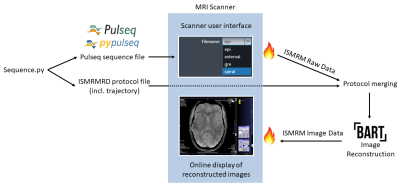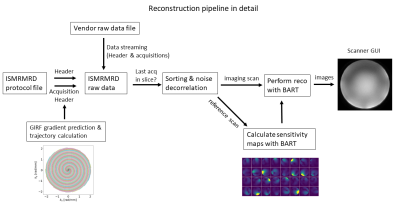Marten Veldmann1, Philipp Ehses1, Kelvin Chow2, Maxim Zaitsev3, and Tony Stöcker1,4
1MR Physics, German Center for Neurodegenerative Diseases (DZNE), Bonn, Germany, 2MR R&D Collaborations, Siemens Medical Solutions USA Inc., Chicago, IL, United States, 3Department of Radiology - Medical Physics, University Medical Center Freiburg, Freiburg, Germany, 4Department of Physics & Astronomy, University of Bonn, Bonn, Germany
1MR Physics, German Center for Neurodegenerative Diseases (DZNE), Bonn, Germany, 2MR R&D Collaborations, Siemens Medical Solutions USA Inc., Chicago, IL, United States, 3Department of Radiology - Medical Physics, University Medical Center Freiburg, Freiburg, Germany, 4Department of Physics & Astronomy, University of Bonn, Bonn, Germany
We propose an open-source imaging workflow including sequence development, execution and online reconstruction. This workflow allows for fast MR sequence prototyping as well as reproducible acquisition, reconstruction, and analysis of imaging data using open source software-tools.

Fig 1: Open-source sequence development and image reconstruction workflow. The Pulseq sequence file and the protocol file are created with Python and exported to the scanner. The sequence can be selected in the scanner GUI and is executed by the interpreter. Acquired data is converted to the ISMRMRD streaming format in real time by the FIRE framework. Before the online reconstruction with the BART toolbox, protocol information is inserted from the protocol file. After reconstruction, images are automatically sent back to the scanner GUI using the ISMRMRD image format.

Fig 2: The reconstruction pipeline starts with continuous data streaming of the raw data to the ISMRMRD format. Header information from the protocol file is inserted into the raw data. Afterwards protocol information for each acquisition is transfered successively. This is accompanied by a trajectory prediction with the GIRF. Acquisitions are collected until data from a whole slice is available. The data is sorted and the reconstruction is performed. If the acquisition is accelerated, sensitivity maps are calculated from a reference scan in a preceding step.
